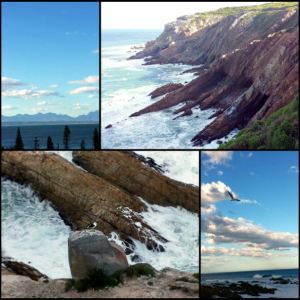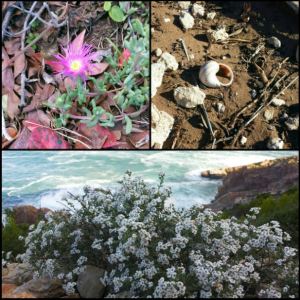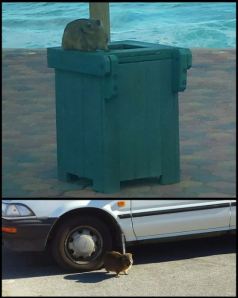The animals in Dynasties were "chosen because they were endangered and because human pressures – especially intrusion into their territory – were adding to an already tough struggle for survival." This is clearly a massive issue, and one I am so happy is getting more and more attention, but it is also one that is often overlooked when it comes to the smaller species or less traditionally 'cute' critters. So I thought today I would consider the human impact on animals that are NOT box office draws and share my take on the dassie dilemma.
"Blaizing" Trails in Mosselbaai:
 |
| Do not let the scenic beauty camouflage what is lying in plain sight |
The trek offers eye catching views for casual walkers as well, with photo ops of seal bounding through foaming waves that crash onto bronze cliffs, a variety of vivid pink, white, red, and yellow wildflowers that help make Mosselbaai a mecca for herbology enthusiasts; gentle fluttering butterflies, glimpses back in time with seashells left behind by ancient natives, and a gradual erosion of rocks to smooth sand. However, the trail's Oystercatcher Path has more secrets than just stone-scratched caves and untold histories hiding in its hills.
 |
| Wildflowers and time smoothed shells are not the only things that lie along the Oystercatcher Path |
South Africa has strict trash and recycling policies in place, and most receptacles are not easily accessible to animals. Mosselbaai requires residents to sort their refuse and dispose of plastics, paper products, and glass properly in the blue bags given to each household by the municipality. With sites like My Waste, finding a center is never an issue, and the city has also set up bins to manage the daily out and about waste. Tourists, however, are not always ready to adapt ritual habits like tossing trash on the ground, picking up dropped items, or feeding wildlife.
 |
| South Africa has policies in place, so why all the litter? |
Why is feeding the adorable dassie an issue? Well, we all know how pervasive an issue plastic has become thanks to features in mainstream media, Twitter chats, and programs like Blue Planet II. If the plastic doesn't cause an immediate crisis to the animal (through a blocked windpipe, lacerated throat, or as a deadly trap), it still poses a threat -- intestinal blockages, slow poisoning due to toxic chemicals that leech out from the innocuous litter, and more -- these plastic snacks are a real danger to these dassies.
Studies have also shown that feeding wild animals, even those as small as this rock rat, can make the creature lose their fear of people and cause them to become a nuisance as they begin to actively seek out sustenance. The problem with panhandling meals to wildlife, especially in areas like the Saint Blaize Trail which begins on the edge of a public area filled with restaurants like Big Blue and snack shacks such as The Waffle Hut, is that the creatures put themselves and others into dangerous situations.
 |
| This cute little critter climbs into open bins and shows no fear of cars |
The Saint Blaize Trail dassies, like the Knysna baboons, have begun to evolve into a local dilemma due to the creatures search for grub. The vegetation surrounding the area is minimal, yet the dassie population continues to grow due to the meals of chips and french fries provided. This association with food has already started to cause problems. There have not been instances of dassies stowing away in vehicles near Oystercatcher Path, but there have been several surprised hikers who arrived hoping for sun and scenic views and left with souvenir bites. The animals also have begun to attempt to seek sanctuary beside automobile wheels. Though cute, the dassie can carry diseases like rabies, making what should be an enjoyable experience dangerous for unsuspecting walkers. Also, despite the population growth, the species is at risk of dying out in Mosselbaai due to their new artificial diets, a death that would leave Hyraceum perfume makers scrambling for ingredients and the Saint Blaize Trail lacking its delightful welcome committee.
Dassies have no qualms about getting up close and personal with human visitors, and in time the minor inconveniences may escalate into a much bigger dilemma. While it's tempting to share a bit of your burger or step over the abandoned bits of rubbish while snapping a panoramic view of the bay to show off on Facebook, take a moment think of the dassie. This creature that made you squeal in childish wonder when you pulled up to Saint Blaize Trail, whose very nature is changing with each human decision that is made, is counting on us to fight for its continued existence.
 |
| Think of the dassie before tossing your trash or feeding your furry friends. Their lives may depend on your actions |















Fascinating piece, thank you. Wild animals being taught to associate humans with food can create such a huge problem. I hope the balance of the Saint Blaize Trail is restored, and that all its creatures are able to thrive in the future.
ReplyDeleteA thought provoking post which I hope lots of people read. Yes, humans do have a devastating impact on the environment and those creatures with whom we share the planet.
ReplyDeleteI have never heard of Dassies but I am enchanted. I grew up in Hawaii and tourists always feed the indigenous creatures junk food that they become accustomed to and dependent upon. It's a vicious cycle.
ReplyDeleteAfter research a couple of the blog posts in your web site now, and I truly like your method of blogging.
ReplyDelete